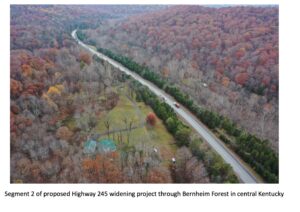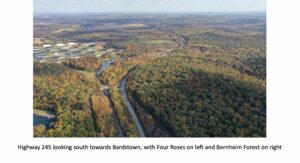By Andrew Berry
A public information meeting was held at Thomas Nelson High School in Nelson County on December 4, 2023, to display plans for widening Highway 245 through Bernheim Forest between Bardstown and I-65. The proposal would increase the width of Highway 245 through Bernheim from 2 lanes to 4 lanes with a median dividing traffic.

The section of Highway 245 considered for widening includes 5 miles that divide Bernheim Forest in the Long Lick Creek watershed. Bernheim is a 16,140-acre arboretum and research forest that protects clean water, linking several watersheds to form a wildlife corridor that supports climate resiliency and biodiversity. It also helps over 300,000 visitors a year through our front gate while providing recreation, education, arts, and opportunities to connect with nature.
We recommend supporters of Bernheim’s wildlife corridors and the Long Lick Creek watershed fill out a questionnaire for the proposed project. Comments are being received until January 6, 2024. Below are links for the information handout distributed at the public meeting:
Using the information handout above, we ask that you fill out the comment questionnaire attached. Below:
Bernheim recommends including this project in Kentucky’s first Wildlife Vehicle Collisions Reduction Plan to protect public and wildlife safety, which has just been awarded federal funding (see below for more information). We recommend improving existing stream culverts into wildlife underpasses to help reduce crossings and collisions on this section of Highway 245. Many animals along Segment 2 have been killed, including turtles, deer, bobcats, coyotes, gray foxes, snakes, opossums, squirrels, raccoons, mink, and even an armadillo. Designing underpasses and roadways to facilitate wildlife movement or discouraging crossings in certain areas will help keep populations connected and healthy for the long term. We also recommend using signage and alerts for motorists to reduce collisions with wildlife.

Bernheim recommends using no concrete barrier for Segment 2’s proposed Highway 245 expansion. We recommend keeping the median flush with the ground without a central rumble strip. If necessary, a double-sided guardrail is preferred over a rumble strip, lipped curb, or concrete barrier for the center median for the 4-lane section. Designs for medians should consider wildlife movement and not act as a permanent barrier for smaller species that cannot cross concrete barriers or raised medians. Wildlife can travel under or over guardrails, allowing movement for species such as turtles, snakes, and all mammals. We do not recommend rumble strip medians because of the excessive noise pollution that would constantly impact Bernheim’s wildlife and visitors.
We are concerned about excessive rock blasting and soil removal that releases carbon, disturbs unstable slopes, and may cause unacceptable levels of runoff and pollution. There is a high risk of Potential Toxic Elements (PTEs) being released from disturbing the black shale geological area near Weller Loop. These long-term impacts would further threaten Long Lick Creek, a watershed that already suffers from highway and railroad runoff and pollution. Stormwater culverts and underpasses should be designed to slow and filter water runoff to reduce erosion and pollution during rain events and help wildlife move safely under the Highway.

Restoration and revegetation of the construction corridor should be carefully considered to maintain ecological and aesthetic quality. This section of Highway 245 should be a model for a scenic highway project in central Kentucky that preserves and enhances our natural and cultural heritage. This project is part of a tourism focus area and a link in the Bourbon Trail. Vegetation should be restored with native species to be beautiful throughout the seasons while also deterring invasive species establishment for species such as kudzu, that would threaten Bernheim Forest.
We recommend that Segment 1 from the Deatsville Loop to Flaget Hospital is the first section to be constructed. This section is most needed due to traffic, and public safety issues associated with the density of neighborhoods, driveways, and businesses. Focusing on Segment 1 first will allow more time for wildlife crossings and water quality mitigation to be studied and funded.
There is some really good news, too; on December 5, 2023, the Federal Highway Administration Wildlife Crossing Program announced $110 million in grants for 19 wildlife crossing projects in 17 states, including four Indian Tribes. Kentucky was selected for $1.2 million in funding wildlife projects, specifically for Kentucky’s first Wildlife Vehicle Collisions Reduction Plan. We recommend that a wildlife crossing study and design on Highway 245 at Bernheim be appropriate for a focus area.
Quoting the recent announcement by the Federal Highways Administration, “The Kentucky Transportation Cabinet (KYTC) will receive $1.2 million to develop Kentucky’s first WVC Reduction Plan in parallel with a pilot corridor study focused on the US-60/I-64 Corridor that will evaluate segments of US 60 and I-64 between the Louisville Metropolitan Area and Frankfort, Kentucky. The statewide plan includes a study to correlate WVC data from different sources, wildlife habitat data, and roadway data to identify priority areas to reduce WVCs and improve habitat connectivity across the state.”
I appreciate your interest in helping focus this project on improving public and wildlife safety. Working together, we hope this can become a model for highway construction in Kentucky.

